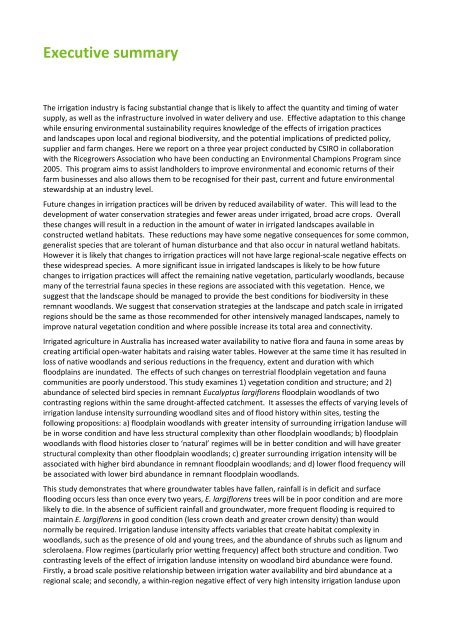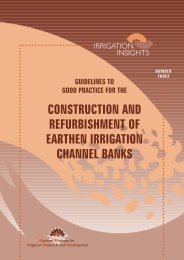The effect of changing irrigation strategies on biodiversity.pdf
The effect of changing irrigation strategies on biodiversity.pdf
The effect of changing irrigation strategies on biodiversity.pdf
Create successful ePaper yourself
Turn your PDF publications into a flip-book with our unique Google optimized e-Paper software.
Executive summary<br />
<str<strong>on</strong>g>The</str<strong>on</strong>g> <str<strong>on</strong>g>irrigati<strong>on</strong></str<strong>on</strong>g> industry is facing substantial change that is likely to affect the quantity and timing <str<strong>on</strong>g>of</str<strong>on</strong>g> water<br />
supply, as well as the infrastructure involved in water delivery and use. Effective adaptati<strong>on</strong> to this change<br />
while ensuring envir<strong>on</strong>mental sustainability requires knowledge <str<strong>on</strong>g>of</str<strong>on</strong>g> the <str<strong>on</strong>g>effect</str<strong>on</strong>g>s <str<strong>on</strong>g>of</str<strong>on</strong>g> <str<strong>on</strong>g>irrigati<strong>on</strong></str<strong>on</strong>g> practices<br />
and landscapes up<strong>on</strong> local and regi<strong>on</strong>al <strong>biodiversity</strong>, and the potential implicati<strong>on</strong>s <str<strong>on</strong>g>of</str<strong>on</strong>g> predicted policy,<br />
supplier and farm changes. Here we report <strong>on</strong> a three year project c<strong>on</strong>ducted by CSIRO in collaborati<strong>on</strong><br />
with the Ricegrowers Associati<strong>on</strong> who have been c<strong>on</strong>ducting an Envir<strong>on</strong>mental Champi<strong>on</strong>s Program since<br />
2005. This program aims to assist landholders to improve envir<strong>on</strong>mental and ec<strong>on</strong>omic returns <str<strong>on</strong>g>of</str<strong>on</strong>g> their<br />
farm businesses and also allows them to be recognised for their past, current and future envir<strong>on</strong>mental<br />
stewardship at an industry level.<br />
Future changes in <str<strong>on</strong>g>irrigati<strong>on</strong></str<strong>on</strong>g> practices will be driven by reduced availability <str<strong>on</strong>g>of</str<strong>on</strong>g> water. This will lead to the<br />
development <str<strong>on</strong>g>of</str<strong>on</strong>g> water c<strong>on</strong>servati<strong>on</strong> <str<strong>on</strong>g>strategies</str<strong>on</strong>g> and fewer areas under irrigated, broad acre crops. Overall<br />
these changes will result in a reducti<strong>on</strong> in the amount <str<strong>on</strong>g>of</str<strong>on</strong>g> water in irrigated landscapes available in<br />
c<strong>on</strong>structed wetland habitats. <str<strong>on</strong>g>The</str<strong>on</strong>g>se reducti<strong>on</strong>s may have some negative c<strong>on</strong>sequences for some comm<strong>on</strong>,<br />
generalist species that are tolerant <str<strong>on</strong>g>of</str<strong>on</strong>g> human disturbance and that also occur in natural wetland habitats.<br />
However it is likely that changes to <str<strong>on</strong>g>irrigati<strong>on</strong></str<strong>on</strong>g> practices will not have large regi<strong>on</strong>al‐scale negative <str<strong>on</strong>g>effect</str<strong>on</strong>g>s <strong>on</strong><br />
these widespread species. A more significant issue in irrigated landscapes is likely to be how future<br />
changes to <str<strong>on</strong>g>irrigati<strong>on</strong></str<strong>on</strong>g> practices will affect the remaining native vegetati<strong>on</strong>, particularly woodlands, because<br />
many <str<strong>on</strong>g>of</str<strong>on</strong>g> the terrestrial fauna species in these regi<strong>on</strong>s are associated with this vegetati<strong>on</strong>. Hence, we<br />
suggest that the landscape should be managed to provide the best c<strong>on</strong>diti<strong>on</strong>s for <strong>biodiversity</strong> in these<br />
remnant woodlands. We suggest that c<strong>on</strong>servati<strong>on</strong> <str<strong>on</strong>g>strategies</str<strong>on</strong>g> at the landscape and patch scale in irrigated<br />
regi<strong>on</strong>s should be the same as those recommended for other intensively managed landscapes, namely to<br />
improve natural vegetati<strong>on</strong> c<strong>on</strong>diti<strong>on</strong> and where possible increase its total area and c<strong>on</strong>nectivity.<br />
Irrigated agriculture in Australia has increased water availability to native flora and fauna in some areas by<br />
creating artificial open‐water habitats and raising water tables. However at the same time it has resulted in<br />
loss <str<strong>on</strong>g>of</str<strong>on</strong>g> native woodlands and serious reducti<strong>on</strong>s in the frequency, extent and durati<strong>on</strong> with which<br />
floodplains are inundated. <str<strong>on</strong>g>The</str<strong>on</strong>g> <str<strong>on</strong>g>effect</str<strong>on</strong>g>s <str<strong>on</strong>g>of</str<strong>on</strong>g> such changes <strong>on</strong> terrestrial floodplain vegetati<strong>on</strong> and fauna<br />
communities are poorly understood. This study examines 1) vegetati<strong>on</strong> c<strong>on</strong>diti<strong>on</strong> and structure; and 2)<br />
abundance <str<strong>on</strong>g>of</str<strong>on</strong>g> selected bird species in remnant Eucalyptus largiflorens floodplain woodlands <str<strong>on</strong>g>of</str<strong>on</strong>g> two<br />
c<strong>on</strong>trasting regi<strong>on</strong>s within the same drought‐affected catchment. It assesses the <str<strong>on</strong>g>effect</str<strong>on</strong>g>s <str<strong>on</strong>g>of</str<strong>on</strong>g> varying levels <str<strong>on</strong>g>of</str<strong>on</strong>g><br />
<str<strong>on</strong>g>irrigati<strong>on</strong></str<strong>on</strong>g> landuse intensity surrounding woodland sites and <str<strong>on</strong>g>of</str<strong>on</strong>g> flood history within sites, testing the<br />
following propositi<strong>on</strong>s: a) floodplain woodlands with greater intensity <str<strong>on</strong>g>of</str<strong>on</strong>g> surrounding <str<strong>on</strong>g>irrigati<strong>on</strong></str<strong>on</strong>g> landuse will<br />
be in worse c<strong>on</strong>diti<strong>on</strong> and have less structural complexity than other floodplain woodlands; b) floodplain<br />
woodlands with flood histories closer to ‘natural’ regimes will be in better c<strong>on</strong>diti<strong>on</strong> and will have greater<br />
structural complexity than other floodplain woodlands; c) greater surrounding <str<strong>on</strong>g>irrigati<strong>on</strong></str<strong>on</strong>g> intensity will be<br />
associated with higher bird abundance in remnant floodplain woodlands; and d) lower flood frequency will<br />
be associated with lower bird abundance in remnant floodplain woodlands.<br />
This study dem<strong>on</strong>strates that where groundwater tables have fallen, rainfall is in deficit and surface<br />
flooding occurs less than <strong>on</strong>ce every two years, E. largiflorens trees will be in poor c<strong>on</strong>diti<strong>on</strong> and are more<br />
likely to die. In the absence <str<strong>on</strong>g>of</str<strong>on</strong>g> sufficient rainfall and groundwater, more frequent flooding is required to<br />
maintain E. largiflorens in good c<strong>on</strong>diti<strong>on</strong> (less crown death and greater crown density) than would<br />
normally be required. Irrigati<strong>on</strong> landuse intensity affects variables that create habitat complexity in<br />
woodlands, such as the presence <str<strong>on</strong>g>of</str<strong>on</strong>g> old and young trees, and the abundance <str<strong>on</strong>g>of</str<strong>on</strong>g> shrubs such as lignum and<br />
sclerolaena. Flow regimes (particularly prior wetting frequency) affect both structure and c<strong>on</strong>diti<strong>on</strong>. Two<br />
c<strong>on</strong>trasting levels <str<strong>on</strong>g>of</str<strong>on</strong>g> the <str<strong>on</strong>g>effect</str<strong>on</strong>g> <str<strong>on</strong>g>of</str<strong>on</strong>g> <str<strong>on</strong>g>irrigati<strong>on</strong></str<strong>on</strong>g> landuse intensity <strong>on</strong> woodland bird abundance were found.<br />
Firstly, a broad scale positive relati<strong>on</strong>ship between <str<strong>on</strong>g>irrigati<strong>on</strong></str<strong>on</strong>g> water availability and bird abundance at a<br />
regi<strong>on</strong>al scale; and sec<strong>on</strong>dly, a within‐regi<strong>on</strong> negative <str<strong>on</strong>g>effect</str<strong>on</strong>g> <str<strong>on</strong>g>of</str<strong>on</strong>g> very high intensity <str<strong>on</strong>g>irrigati<strong>on</strong></str<strong>on</strong>g> landuse up<strong>on</strong>

















